PEP小学英语四年级上册 Unit 4 My home B Read and write教案
- 格式:doc
- 大小:816.00 KB
- 文档页数:8
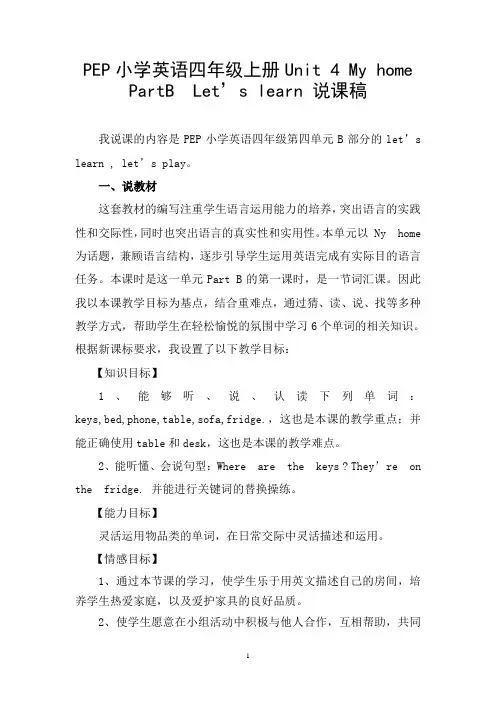
PEP小学英语四年级上册Unit 4 My home PartB Let’s learn 说课稿我说课的内容是PEP小学英语四年级第四单元B部分的let’s learn , let’s play。
一、说教材这套教材的编写注重学生语言运用能力的培养,突出语言的实践性和交际性,同时也突出语言的真实性和实用性。
本单元以 Ny home 为话题,兼顾语言结构,逐步引导学生运用英语完成有实际目的语言任务。
本课时是这一单元Part B的第一课时,是一节词汇课。
因此我以本课教学目标为基点,结合重难点,通过猜、读、说、找等多种教学方式,帮助学生在轻松愉悦的氛围中学习6个单词的相关知识。
根据新课标要求,我设置了以下教学目标:【知识目标】1、能够听、说、认读下列单词:keys,bed,phone,table,sofa,fridge.,这也是本课的教学重点;并能正确使用table和desk,这也是本课的教学难点。
2、能听懂、会说句型:Where are the keys ? They’re on the fridge. 并能进行关键词的替换操练。
【能力目标】灵活运用物品类的单词,在日常交际中灵活描述和运用。
【情感目标】1、通过本节课的学习,使学生乐于用英文描述自己的房间,培养学生热爱家庭,以及爱护家具的良好品质。
2、使学生愿意在小组活动中积极与他人合作,互相帮助,共同完成学习任务。
二、说教法为了顺利完成教学目标,更好地突出重点,突破难点,按照学生的认识规律,我采用情景假设法、直观演示法、交际法、游戏法相结合的方法。
兴趣是学生最好的老师,小学低年级英语更注重趣味教学,在课堂上适当运用肢体语言、游戏法,激发学生学习英语的兴趣,进而促使学生由兴趣发展到产生要学好它的志趣。
教师通过直观演示法,引导学生用英语表达自己的思想和感受。
在调动学生积极性和主动性方面,我采用了游戏法,让全班参与其中,形成师生互动,提高教学效果。
三、说学法小学四年级学生已经学了一年的英语,已掌握了基本的听、说、认读能力,已具备了一定的自学能力。

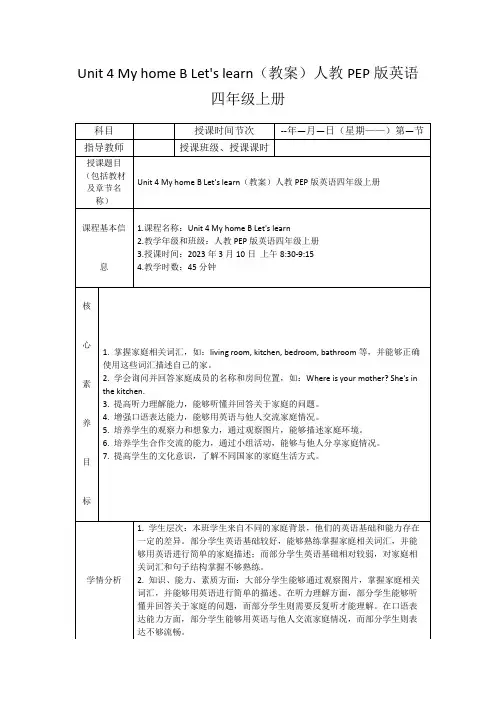
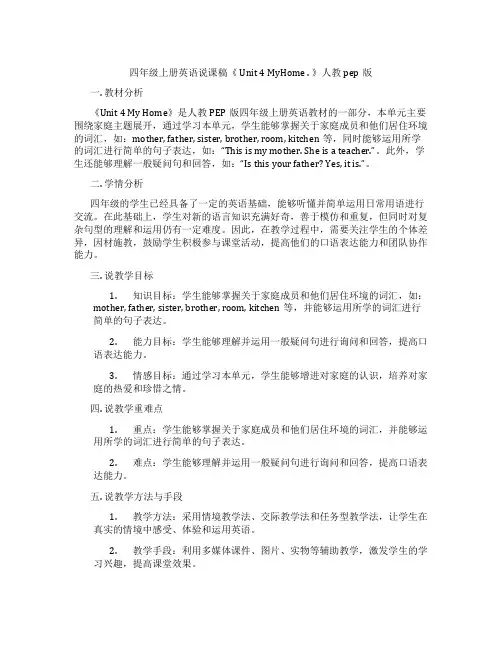
四年级上册英语说课稿《 Unit 4 MyHome . 》人教pep版一. 教材分析《Unit 4 My Home》是人教PEP版四年级上册英语教材的一部分,本单元主要围绕家庭主题展开,通过学习本单元,学生能够掌握关于家庭成员和他们居住环境的词汇,如:mother, father, sister, brother, room, kitchen等,同时能够运用所学的词汇进行简单的句子表达,如:“This is my mother. She is a teacher.”。
此外,学生还能够理解一般疑问句和回答,如:“Is this your father? Yes, it is.”。
二. 学情分析四年级的学生已经具备了一定的英语基础,能够听懂并简单运用日常用语进行交流。
在此基础上,学生对新的语言知识充满好奇,善于模仿和重复,但同时对复杂句型的理解和运用仍有一定难度。
因此,在教学过程中,需要关注学生的个体差异,因材施教,鼓励学生积极参与课堂活动,提高他们的口语表达能力和团队协作能力。
三. 说教学目标1.知识目标:学生能够掌握关于家庭成员和他们居住环境的词汇,如:mother, father, sister, brother, room, kitchen等,并能够运用所学的词汇进行简单的句子表达。
2.能力目标:学生能够理解并运用一般疑问句进行询问和回答,提高口语表达能力。
3.情感目标:通过学习本单元,学生能够增进对家庭的认识,培养对家庭的热爱和珍惜之情。
四. 说教学重难点1.重点:学生能够掌握关于家庭成员和他们居住环境的词汇,并能够运用所学的词汇进行简单的句子表达。
2.难点:学生能够理解并运用一般疑问句进行询问和回答,提高口语表达能力。
五. 说教学方法与手段1.教学方法:采用情境教学法、交际教学法和任务型教学法,让学生在真实的情境中感受、体验和运用英语。
2.教学手段:利用多媒体课件、图片、实物等辅助教学,激发学生的学习兴趣,提高课堂效果。
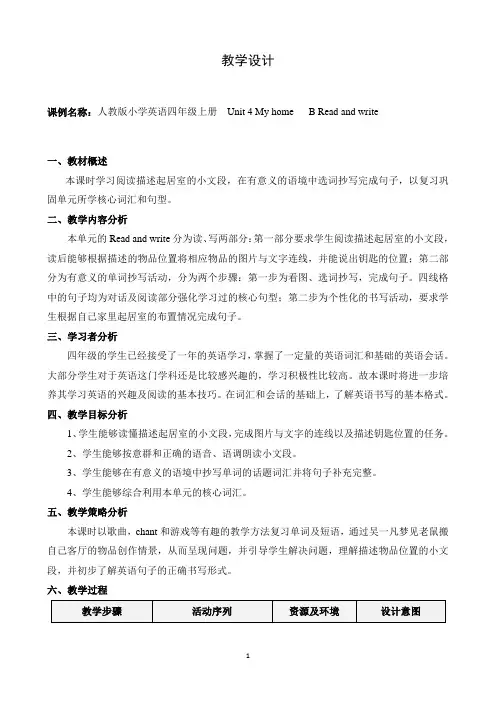
教学设计课例名称:人教版小学英语四年级上册Unit 4 My home B Read and write一、教材概述本课时学习阅读描述起居室的小文段,在有意义的语境中选词抄写完成句子,以复习巩固单元所学核心词汇和句型。
二、教学内容分析本单元的Read and write分为读、写两部分:第一部分要求学生阅读描述起居室的小文段,读后能够根据描述的物品位置将相应物品的图片与文字连线,并能说出钥匙的位置;第二部分为有意义的单词抄写活动,分为两个步骤:第一步为看图、选词抄写,完成句子。
四线格中的句子均为对话及阅读部分强化学习过的核心句型;第二步为个性化的书写活动,要求学生根据自己家里起居室的布置情况完成句子。
三、学习者分析四年级的学生已经接受了一年的英语学习,掌握了一定量的英语词汇和基础的英语会话。
大部分学生对于英语这门学科还是比较感兴趣的,学习积极性比较高。
故本课时将进一步培养其学习英语的兴趣及阅读的基本技巧。
在词汇和会话的基础上,了解英语书写的基本格式。
四、教学目标分析1、学生能够读懂描述起居室的小文段,完成图片与文字的连线以及描述钥匙位置的任务。
2、学生能够按意群和正确的语音、语调朗读小文段。
3、学生能够在有意义的语境中抄写单词的话题词汇并将句子补充完整。
4、学生能够综合利用本单元的核心词汇。
五、教学策略分析本课时以歌曲,chant和游戏等有趣的教学方法复习单词及短语,通过吴一凡梦见老鼠搬自己客厅的物品创作情景,从而呈现问题,并引导学生解决问题,理解描述物品位置的小文段,并初步了解英语句子的正确书写形式。
六、教学过程六、教学资源本课时在多媒体的教学环境,以吴一凡梦见老鼠搬客厅的物品为主线,在网络收集了大量相关图片、哭声、对话录音、两段限时音乐和flash动画等资源制作PPT课件。
利用卡纸、透明胶纸制作转盘和反面词条,并准备若干打印的拓展资源。
七、评价方法与工具课堂学案课例名称:人教版小学英语四年级上册Unit 4 My Home B Read and write教学内容:课本P43的Read and match和Look, choose and write.教学目标:1、学生能够读懂描述起居室的小文段,完成图片与文字的连线以及描述钥匙位置的任务。
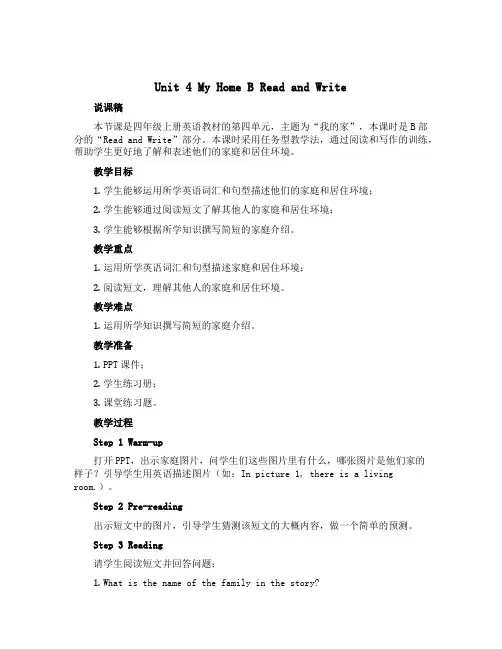
Unit 4 My Home B Read and Write说课稿本节课是四年级上册英语教材的第四单元,主题为“我的家”,本课时是B部分的“Read and Write”部分。
本课时采用任务型教学法,通过阅读和写作的训练,帮助学生更好地了解和表述他们的家庭和居住环境。
教学目标1.学生能够运用所学英语词汇和句型描述他们的家庭和居住环境;2.学生能够通过阅读短文了解其他人的家庭和居住环境;3.学生能够根据所学知识撰写简短的家庭介绍。
教学重点1.运用所学英语词汇和句型描述家庭和居住环境;2.阅读短文,理解其他人的家庭和居住环境。
教学难点1.运用所学知识撰写简短的家庭介绍。
教学准备1.PPT课件;2.学生练习册;3.课堂练习题。
教学过程Step 1 Warm-up打开PPT,出示家庭图片,问学生们这些图片里有什么,哪张图片是他们家的样子?引导学生用英语描述图片(如:In picture 1, there is a living room.)。
Step 2 Pre-reading出示短文中的图片,引导学生猜测该短文的大概内容,做一个简单的预测。
Step 3 Reading请学生阅读短文并回答问题:1.What is the name of the family in the story?2.How many people are in the family?3.What do they have in the living room?4.What is behind the sofa?5.What is near the table?Step 4 Writing引导学生总结所学句型,并在本节课练习册中完成写作任务,撰写一篇简短的家庭介绍。
Step 5 Extension分发练习题,让学生运用所学知识进行口语练习。
练习题的内容包括:1.询问家庭成员;2.描述家中家具和房间;3.自我介绍和家庭介绍。
总结本节课主要通过阅读和写作的训练,帮助学生更好地表述他们的家庭和居住环境。
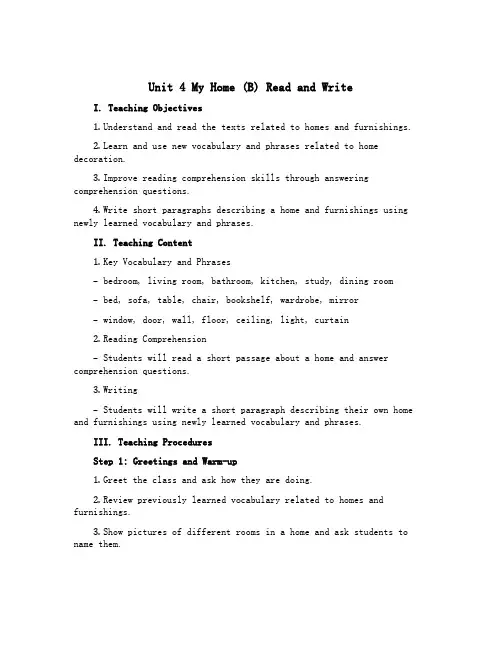
Unit 4 My Home (B) Read and WriteI. Teaching Objectives1.Understand and read the texts related to homes and furnishings.2.Learn and use new vocabulary and phrases related to home decoration.3.Improve reading comprehension skills through answering comprehension questions.4.Write short paragraphs describing a home and furnishings using newly learned vocabulary and phrases.II. Teaching Content1.Key Vocabulary and Phrases–bedroom, living room, bathroom, kitchen, study, dining room–bed, sofa, table, chair, bookshelf, wardrobe, mirror–window, door, wall, floor, ceiling, light, curtain2.Reading Comprehension–Students will read a short passage about a home and answer comprehension questions.3.Writing–Students will write a short paragraph describing their own home and furnishings using newly learned vocabulary and phrases.III. Teaching ProceduresStep 1: Greetings and Warm-up1.Greet the class and ask how they are doing.2.Review previously learned vocabulary related to homes and furnishings.3.Show pictures of different rooms in a home and ask students to name them.Step 2: Introduction to New Vocabulary1.Introduce the new vocabulary and phrases related to home decoration using flashcards.2.Demonstrate the pronunciation and spelling of each word and practice with the class.3.Ask students to repeat the words and use them in simple sentences.Step 3: Reading Comprehension1.Read the short passage about a home to the class.2.Explain any unfamiliar words or phrases and ask comprehension questions.3.Allow students to read the passage on their own and answer the comprehension questions in pairs or small groups.4.Check the answers with the class.Step 4: Writing Activity1.Ask students to write a short paragraph describing their own home and furnishings using the newly learned vocabulary and phrases.2.Walk around the classroom and check for understanding and correct any mistakes.3.Ask some students to share their paragraphs with the class.Step 5: Conclusion and Reflection1.Review the new vocabulary and phrases learned in class.2.Ask students to reflect on what they have learned and how they can use it in their daily lives and interactions with others.3.Assign homework to reinforce the new vocabulary and phrases.IV. Homework1.Review and practice the newly learned vocabulary and phrases.2.Write a longer paragraph describing a dream home using the new vocabulary and phrases.3.Read a book or article related to homes or interior design in English.。
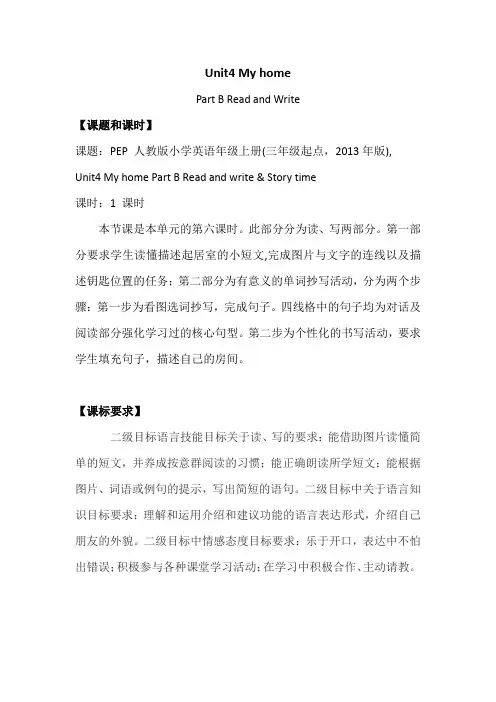
Unit4 My homePart B Read and Write【课题和课时】课题:PEP 人教版小学英语年级上册(三年级起点,2013年版),Unit4 My home Part B Read and write & Story time课时:1 课时本节课是本单元的第六课时。
此部分分为读、写两部分。
第一部分要求学生读懂描述起居室的小短文,完成图片与文字的连线以及描述钥匙位置的任务;第二部分为有意义的单词抄写活动,分为两个步骤:第一步为看图选词抄写,完成句子。
四线格中的句子均为对话及阅读部分强化学习过的核心句型。
第二步为个性化的书写活动,要求学生填充句子,描述自己的房间。
【课标要求】二级目标语言技能目标关于读、写的要求:能借助图片读懂简单的短文,并养成按意群阅读的习惯;能正确朗读所学短文;能根据图片、词语或例句的提示,写出简短的语句。
二级目标中关于语言知识目标要求:理解和运用介绍和建议功能的语言表达形式,介绍自己朋友的外貌。
二级目标中情感态度目标要求:乐于开口,表达中不怕出错误;积极参与各种课堂学习活动;在学习中积极合作、主动请教。
【学习目标】通过本节课的学习,学生能够:1、能听懂、会说、认读本单元的重点词汇和句型。
2、能在意义的语境中抄写单元的话题词汇并将句子填充完整。
3、通过阅读趣味故事,复习巩固本单元所学语言,增加学生语言的输入。
4、能够主动收拾物品并摆放整齐,养成良好的生活习惯。
【评价设计】【资源建议】1、活页类资源:练习纸2、图(卡)片类资源:单词图片、板书3、多媒体类资源:PPT 音频视频【学习过程】Step1: Review1. Greetings.2. Enjoy the song—My home.Play the song of “Let’s sing”. (课件出示:教材P44 Let’s sing板块的歌曲)3. Sharp eyes.Present the vocabulary “bedroom, living room, study, kitchen, bathroom, key, sofa, bed, fridge, table, phone”one by one. (出示课件) Ask students to read them out. Write down the vocabulary on the blackboard.4. Revision.Present the picture of “Let’s learn”on page 42. (出示课件)Talk about the picture with students.T: This is a bedroom. It has a blue bed. The bed is near the window. A teddy bear is on the bed. (课件出示:This is...room. It has a... The ... is near the ... A ... is on the... )Step 2: Learn1. Pre-reading.Present the picture of Wu Yifan’s living room. (课件出示:教材P43 Read and write板块中吴一凡家的客厅图片)T: Look, this is Wu Yifan’s living room. What are in the living room? Ss: A TV, a table, a fridge, a phone and a sofa.T: Where is the TV?S1: It’s on the wall.T: Where is the phone?S2: It’s on the table.T: Where is the fridge?S3: It’s near the table.T: Oh, the living room is clean and tidy.(课件出示:教材P43 Read and match左侧的物品图片)There are some books and pens, a bag and a pair of glasses. Guess! Where are the books? Where are the pens? Where is the bag? And where are the glasses?Ss: …2. While-reading.(1) Present the passage of “Read and write”. (出示课件)Ask students to read the passage carefully. Pay attention to underliningthe key phrases of the questions.T: Where are the books? Where are the pens? Where is the bag? Where are the glasses? Now put these things in the right places.Answer the questions and match.(2) Check the answers with students.Answers: 1. The books are on the sofa.2. The pens are on the fridge.3. The bag is under the table.4. The glasses are near the phone.T: Wu Yifan can’t find his keys. Can you help him? Where are the keys? Ask students to look at the picture of Wu Yifan’s living room again and find the keys. (出示课件)Ss: They are near the sofa.(3) Listen to the recording and repeat it.①Read after the recording.②Read the passage together.③Repeat the text.3. Post-reading.(1) Look, choose and write. (课件出示:教材P43 Look, choose and write 中第一部分的图片及练习)Let students read the vocabulary “living room, bedroom, kitchen,bathroom, study”first.T: Let’s go and visit other rooms. Look at Picture 1. Answer the questions: Where is the sofa? Where is the picture?Ss: The sofa is in the living room. The picture is on the wall. It’s in the living room, too.T: Look at Picture 2. Where is the bed? Where are the chairs?Ss: The bed is in the bedroom. The chairs are in the bedroom, too.T: Great! Let’s finish the exercises.Finish the exercises and check the answers.Answers: The sofa is in the living room. The chairs are in the bedroom. (2) Write about your room. (课件出示:整洁的客厅图片与脏乱的客厅图片)T: Which room do you like? …Yes. Picture 1. East or west, home is the best. We must keep our home clean and tidy. After visiting Wu Yifan’s home, you may have some ideas about your room. Now write about your room in your book.(课件出示:Look, choose and write中第二部分的图片及练习)Let students read the words “phone, sofa, table, chairs, fridge, bed”together first.T: When you write sentences, you should pay attention to capitalizing the first letter, the punctuation marks and the spelling of words. After that, please share your ideas with your partner. Let’s do it!Answers: The TV is in the living room. The books are in the study.(3) Listen and tick or cross.①Present the pictures of “Listen and tick or cross”. (课件出示:教材P44 Listen and tick or cross部分的图片)T: Can you see the glasses in the first picture? Where are they?S1: …T: Can you see the keys in the second picture? Where are they?S2: …T: Where are the books in the third picture?S3: …T: Where is Mike?S4: …②Listen and tick or cross.T: Now, please listen and tick or cross. (课件出示:教材P44 Listen and tick or cross部分的音频) Pay attention to the key words.③Check the answers.Listen to the recording again and check the answers together. Answers: √×√×(4)Look and tick.①Present the pictures of “FOR RENT”of “Look and tick”.(出示课件)T: “For rent”means “出租”. What can we know from the ads? Pleasediscuss with your partner.S1:It has two bedrooms, a living room, a kitchen and two bathrooms in the first “FOR RENT”.S2: It has a bedroom, a living room, a kitchen and a bathroom in the second “FOR RENT”.②Present the picture of the house in “Look and tick”. (课件出示:教材P44 Look and tick部分中右边房子的图片)T: Look at the picture. How many rooms are there? What are they?Ss: Four rooms. A bedroom, a living room, a kitchen and a bathroom. T: Now, look and tick. Which is right? Show me your answer, please.③Check the answer.Answer: The second “FOR RENT”is right.(5)Story time1.Watch and answer①What are they doing?②Where are the glasses?2.教师呈现打乱顺序的故事图片,再次播放视频请学生根据故事发展的顺序重新排序。
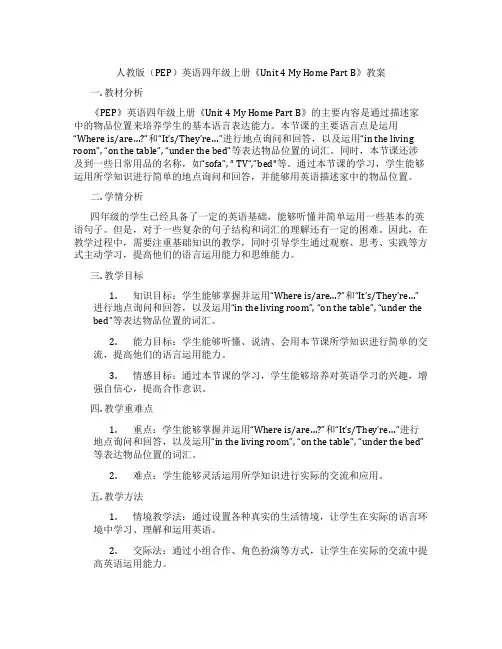
人教版(PEP)英语四年级上册《Unit 4 My Home Part B》教案一. 教材分析《PEP》英语四年级上册《Unit 4 My Home Part B》的主要内容是通过描述家中的物品位置来培养学生的基本语言表达能力。
本节课的主要语言点是运用“Where is/are…?”和“It’s/They’re…”进行地点询问和回答,以及运用“in the living room”, “on the table”, “under the bed”等表达物品位置的词汇。
同时,本节课还涉及到一些日常用品的名称,如“sofa”, " TV“,”bed"等。
通过本节课的学习,学生能够运用所学知识进行简单的地点询问和回答,并能够用英语描述家中的物品位置。
二. 学情分析四年级的学生已经具备了一定的英语基础,能够听懂并简单运用一些基本的英语句子。
但是,对于一些复杂的句子结构和词汇的理解还有一定的困难。
因此,在教学过程中,需要注重基础知识的教学,同时引导学生通过观察、思考、实践等方式主动学习,提高他们的语言运用能力和思维能力。
三. 教学目标1.知识目标:学生能够掌握并运用“Where is/are…?”和“It’s/They’re…”进行地点询问和回答,以及运用“in the living room”, “on the table”, “under the bed”等表达物品位置的词汇。
2.能力目标:学生能够听懂、说清、会用本节课所学知识进行简单的交流,提高他们的语言运用能力。
3.情感目标:通过本节课的学习,学生能够培养对英语学习的兴趣,增强自信心,提高合作意识。
四. 教学重难点1.重点:学生能够掌握并运用“Where is/are…?”和“It’s/They’re…”进行地点询问和回答,以及运用“in the living room”, “on the table”, “under the bed”等表达物品位置的词汇。
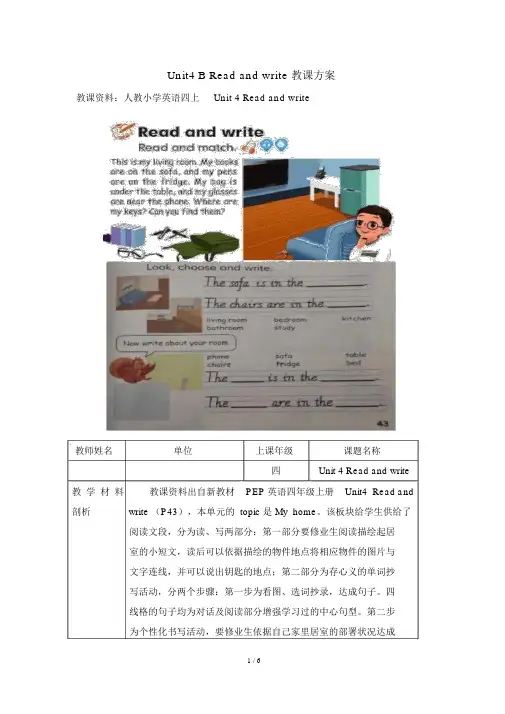
Unit4 B Read and write 教课方案教课资料:人教小学英语四上Unit 4 Read and write教师姓名单位上课年级课题名称四Unit 4 Read and write 教学材料教课资料出自新教材PEP 英语四年级上册Unit4 Read and 剖析write (P43),本单元的 topic 是 My home。
该板块给学生供给了阅读文段,分为读、写两部分:第一部分要修业生阅读描绘起居室的小短文,读后可以依据描绘的物件地点将相应物件的图片与文字连线,并可以说出钥匙的地点;第二部分为存心义的单词抄写活动,分两个步骤:第一步为看图、选词抄录,达成句子。
四线格的句子均为对话及阅读部分增强学习过的中心句型。
第二步为个性化书写活动,要修业生依据自己家里居室的部署状况达成句子。
教学设计本节课是一节阅读写作课。
教课中主要以描绘房间里有哪些说明物件,这些物件分别在哪里为主线,以The is the ... 和教课内容确立The are the 为主要描绘句型。
先让学生对我家的客堂进行语言点的转动输出,而后进入文本,经过读文、读图对文本进行多层次阅读,进一步稳固了本节课的描绘性语言,最后用已学的知识来描绘同学的房间,自己的房间,小组合作将议论的结果作好记录,真切达到语用的目的。
Read and writeThis is my living room. My books are on the sofa, and my pens are on the fridge. My bag is under the table, and my glasses are near the phone. Where are my keys? Can you find them?教课目的知识目标:定位 1. 可以读懂理解书上的小短文,达成图片与文字的连线以及描绘钥匙地点的任务。
2. 能按意群和正确的语音、语调朗诵文本。
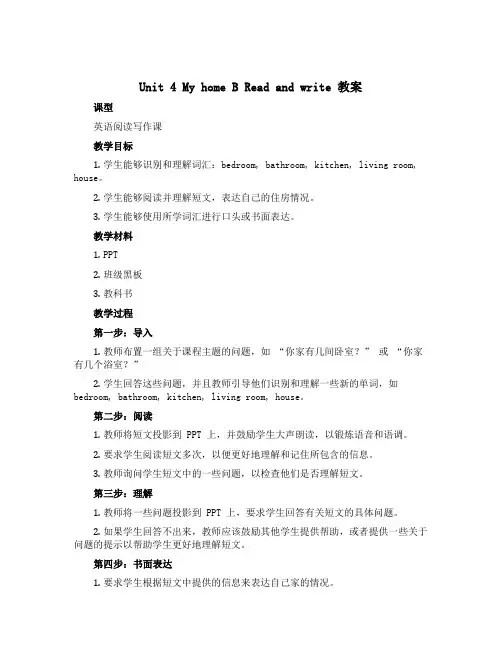
Unit 4 My home B Read and write 教案课型英语阅读写作课教学目标1.学生能够识别和理解词汇:bedroom, bathroom, kitchen, living room, house。
2.学生能够阅读并理解短文,表达自己的住房情况。
3.学生能够使用所学词汇进行口头或书面表达。
教学材料1.PPT2.班级黑板3.教科书教学过程第一步:导入1.教师布置一组关于课程主题的问题,如“你家有几间卧室?” 或“你家有几个浴室?”2.学生回答这些问题,并且教师引导他们识别和理解一些新的单词,如bedroom, bathroom, kitchen, living room, house。
第二步:阅读1.教师将短文投影到 PPT 上,并鼓励学生大声朗读,以锻炼语音和语调。
2.要求学生阅读短文多次,以便更好地理解和记住所包含的信息。
3.教师询问学生短文中的一些问题,以检查他们是否理解短文。
第三步:理解1.教师将一些问题投影到 PPT 上,要求学生回答有关短文的具体问题。
2.如果学生回答不出来,教师应该鼓励其他学生提供帮助,或者提供一些关于问题的提示以帮助学生更好地理解短文。
第四步:书面表达1.要求学生根据短文中提供的信息来表达自己家的情况。
2.学生可以使用之前上课学习的新词汇来描述自己的家庭。
3.学生可以将自己的作品分享给同学,并相互进行评价和提供建议。
第五步:总结1.学生进行单词复习,教师可以使用游戏的方式帮助学生复习单词。
2.教师可能想向学生展示一些图片或视频,让他们更好地了解所学的词汇。
课堂作业1.要求学生阅读英语杂志或有关住房的网站,并写一篇有关他们家的必妥酷炫的文章。
2.学生应该使用他们在上课中学到的单词,描述自己家庭的情况。
教育理念通过学习Metacognition的方法,将学生置于学习和学习能力的中心,以帮助他们自主地学习,并把握他们自己的进展。
总结这门课程旨在让学生了解一些常用的住房词汇,以便他们能够表达和描述自己的家庭。
四年级英语上册PEP Unit 4 《My Home》Part B说课稿四年级上册PEP Unit 4 《My Home》 Part B说课稿我说课的内容是小学英语四年级上册PEP教材中Unit 4,Part B的第三课时。
本单元主要是围绕家里的各类房间living room、study、kitchen、bedroom and bathroom及一些常见的生活用品和家具phone、fridge、TV、sofa、table、shelf and bed等展开的一系列话题,这些东西都是学生非常熟悉而且和我们息息相关的,所以教师教起来比较顺手,学生也乐于学习,并易于在生活中进行运用。
本课时共分为两个部分,第一部分,Read andwrite,这部分主要为学生提供了一幅较为形象的图片来教授五个要求听、说、读、写都能达到的四会单词。
第二部分,Write and say,这部分主要是通过写一写、说一说的活动,从而巩固第一部分所学的五个四会单词。
此部分是为培养学生语感、复习前面所学内容及运用语言表达的能力、为活跃课堂和培养兴趣而设置的。
本节课的教学目标和要求是:能听、说、读、写window 、door 、desk、chair、bed这五个单词,并能运用这五个四会单词看图填空,能用What can you see in my room? It is a nice room. I like it等句子,结合学过的语言来描述自己或他人的房间及室内家具陈设的名称、特征等。
如:This is my room, It is big, I have a window 、a door 、a desk、a chair and a bed .本课时重点及难点内容是:让学生掌握Read and write 部分单词的拼写,My Home这是一个和学生的实际生活有着密切联系的内容。
特别是在学习了家具desk、chair、bed 这些名称以后再学习句子What can you see in my room?使得学生更能融入生活的情境,从而培养学生对家的热爱。
附件2寻乌县2022年小学英语优秀教学设计模板read the words and sentences on the white board.有一个整体的记忆。
Assigns the homework:Design a newroom and write about it.Listenandthink.通过设计和介绍自己喜欢的房间,提升学生的学习兴趣,巩固所学知识。
Unit 4 My home本节课围绕这一单元的主题My home ,我根据本节课的教学内容与学生熟知的《朵拉历险记》的游戏规则巧妙地相结合,设置了穿越丛林、通过山洞,攀登雪山等环节贯穿整节课。
本节课我采用任务型教学法,将本节的教学内容按照“趣味复习——突破难点——快乐阅读——共同写作——共同分享”的顺序进行高效的以读促写教学。
在处理这些教学内容时,我把重点放在了阅读和写作上,引导学生带着目的去阅读,从中获取相关信息,并模仿录音训练语音语调,让学生通过阅读短文,仔细观察,口头描述,最后进行仿写,从而达到以读促写的目的。
在语法教学中,注重引导学生发现is 和are 用法的区别,并引导学生归纳出两者与单数名词和复数名词使用时的规则,为学生的写作提供了坚实的基础。
此外,在评价方法的选择上,我采用了小组评价和个人评价相结合的评价方法,极大地调动了学生的学习热情,让学生乐中学,学中乐,共同体验英语阅读与写作带来window schoolbag dog toyisfan s doors picture s glass esareThe window is in the study.The glasses are on the desk.Group 1Group 2四年级上册Unit 4 My home Read and Write英语学案一、教学目标:知识目标:1. 能够读懂理解书上的小短文,完成图片与文字的连线以及描述钥匙位置的任务。
2. 能按意群和正确的语音、语调朗读文本。
Unit4 B Read and write教案一、教学目标能够读懂描述起居室的小短文,找出物品的单词,完成物品图片与位置的连线以及描述钥匙位置的任务;能够按意群和正确的语音、语调朗读小短文;能够在有意义的语境中抄写单元的话题词汇并将句子补充完整;能够综合运用本单元的核心词句填写最美家居大赛的报名表。
二、学情分析学生已经在A部分学习了家里的各个功能室及里面家具的表达和单数物品在哪的表达,在B部分学习了复数物品在哪的表达。
三、重点难点重点:句子词汇:My books are on the sofa. My pens are on the fridge. My bag is under the table. My glasses are near the phone. 生词:them。
难点:语言知识点:一般现在时(be动词单复数形式的转换);介词on, in, under, near 的使用。
四、教学过程活动1【导入】一、Pre- reading1. Lead in. T: Today let’s learn U4 My Home. Hey, here is a competition. Let’s go and have a look. Amy, John, Wu Yifan, Zhang Peng, Mike takes part in the match, too.2. Review the furniture and sentences, talk about the furniture you see in Amy’s home and Johns’, then answer the questions: Where is the cat? Where are the keys? T: What does Amy have in her house? Where is the cat? How about John’s? Where are the keys?活动2【讲授】二、While-readingWu Yifan’s room.1. First reading: Read and underline the things in Wu Yifan’s room(板书:物品books,pens, bag, glasses)T: Look at Wu Yifan’s room. What room is it? S: Living room. T: This is Wu Yifan’s living room. What does Wu Yifan have in his room? Open your books, please! Turn to P43 and underline what Wu Yifan has in his room.2. Second reading: read and match. 板书:介词短语。
PEP小学英语四年级上册Unit 4 My Home一、教学内容1.词汇:living room,bathroom,kitchen,study,bedroom,sofa,fridge…2.句型:--Where is/are….(sofa,fridge,keys,glasses…)?--The… is /are in the (living room, bathroom, kitchen, study, bedroom,..)二、教学目标1.能够完成以下练习Read and match:Look , choose and write。
Listen and tick or cross。
2.检测部分要求学生能够熟练地听、说本单元对话部分的主要句型;能够听、说、认读词汇部分的所有单词。
3.读懂Story time 的故事三、教学重难点:教学重点:能够掌握一些解题技巧教学难点:听力练习的判断及is/are的灵活运用四、教学准备:教学课文MP3 ,自制单词卡,教学课件,利用教室现存的实物。
五、教学过程:(一)热身/复习(Warm-up/Revision)1、Greeting问候2、Enjoy a song :Where is Mr.Monkey?通过歌曲激发学生兴趣,老师边唱边演示动作,同时复习之前学过的under,in,on,next to,near等介词,重点突出near 和next to的区别,以便后面课文中学生对near的理解。
3、听完歌曲后请学生回答Where is My Monkey?---It’s in the box.此处很多学生估计没有认真听和看,说不出准确答案,后来把视频回放部分,又看了一次才得出正确答案。
(二)呈现新课(Presentation)1、Find and Say 边找边说A.出示图片,老师提问:Where is the apple?学生回答:The apple is on the chair.B.出示图片,老师提问:Where is the orange?学生回答:The orange is under the chair.C.出示图片,老师提问:Where is the pear?学生回答:The pear is near the chair.D.出示图片,老师提问:Where is the banana?学生回答:The banana is in the box. 最后,出示答句The is 。
PEP教材小学英语单元书面(课后)作业设计表整体设计思路本单元的整体设计思路是基于学生学情,立足教材单元内容,围绕培养学生的英语学科核心素养进行一系列整体性、递进性、综合性的作业设计。
通过梳理、整合本单元的教学内容和相关教学资源,创设真实的生活语境,设计层层递进的作业活动,培养学生的语言能力、学习能力、思维品质和文化品格;在合理整合教学内容的基础上,补充课程资源,创设任务促进学生独立思考、自主探究、合作学习、实践体验,促进学生的全面发展。
本单元的作业设计注重任务型的实践性作业,通过创设搬新家、找物品、整理房间、帮助家中老人找物品等生活情景,引导学生在介绍房间、寻找物品、整理物品、分担家务的过程中,运用所学语言描述家中居室和物品的位置关系,学习合理整理、科学收纳的方法,初步建立正确整理收纳物品、物放有序的良好生活习惯,并在这个过程中感悟分担家务劳动,保持居家整洁的重要性,进而结合真实的生活经验,自我反思,学习做一个有条理的人,培养良好的生活习惯。
Part 1. Wele to my home对应课文A. Let’s talk & Let’s learn作业目标1.能听、说、读、认living room, kitchen, bedroom, bathroom, study等关于家中居室的目标语言;2.能够在语境中运用所学语言问答、描述物品的位置关系;3.能够合理摆放房间里的物品,并能对家中物品的摆放提出合理有效的建议。
4. 体会物放有序的良好习惯给生活带来的便利。
从左到右:bedroom, kitchen, study, bathroom, living room第二部分:watch TV, read books, have a snack, have a nap, take a shower参考答案:This is the study. It’s great. I can read books in the study. I can work here,Are they on the table? under the table鸭舌帽:沙发上。
Unit 4 My home B Read and write一、教学版本:义务教育课程标准实验教科书PEP第三册Unit four My home B-Read and write.二、教学理念: 注重学生语言应用能力的培养,主要任务是学会学习,培养学生自主学习能力和创新能力。
本课从整体构思、内容安排,活动设计和教学方法都紧密联系学生的生活实际,以情景主线贯穿整个教学过程,真正体现了语言的真实性,同时,把知识和技能目标融会在完成任务的过程之中。
三、教学对象分析:四年级的学生学习英语,有着很强的兴趣和好奇心,模仿力较强,表现欲旺盛。
课堂上我抓住学生好动的特点,多给学生参与的机会。
因学习的难度较大,容易分散注意力,这就要求老师以学生为主体,通过多种不同方式和活动去巩固课堂内容。
四、教学策略:通过让学生自己动口、动手、动脑进行活动交流,让学生在一定的情景中运用语言进行有意义的表达,使不同水平层次的学生都积极学习、都有所收获。
采用小组合作学习法、听读训练法和故事教学法,多媒体辅助法,以学生为主体,以活动为媒介,从学生兴趣、认知水平出发,利用课件、information gap以及设计自己房间展开丰富多彩的活动,让学生在引导下进行语言交流,感受用英语交流的乐趣和成功感,从而提高学生用英语进行交流的能力。
五、教学目标与要求:(一)语言知识目标:1)能读懂四级句子并与图中的人物正确匹配;2)能够按意群和正确的语音语调朗诵四组句子;3)能在有意义的语境中抄写单元的话题词汇并将句子补充完整。
(二)语言技能目标:1)发展学生在听、说、认读方面的能力。
2)培养学生自主思考,与小组合作探究的能力。
3)培养学生积极主动地参与课堂活动,大胆开口。
(三)情感目标:培养学生主动帮助朋友,并学会自主整理房间的生活习惯。
六、教学重点:掌握部分单词的读、写能力,并能在一定的语境下运用。
教学难点:根据所学内容在小组中设计房间,并能用口头表达。
七、课前准备:多媒体课件,家具贴纸,卡纸等八:教学过程:(一) Warm-up1,师生日常对话: Hello! How are you? What` s your name? I`m ……2,Introduce a friend (Goldilocks) to the class.(展示Goldie想要去其他地方的图片)教师设置悬念:But where is Goldie going to? Let’s go and have a look!(设计意图:师生相互认识,拉近关系,并通过介绍一个朋友给大家认识为阅读前的环节做铺垫。
)(二)Presentation1.Pre-readingT(展示图片):Where is she?Ss: She is in the kitchen/living room.T: what can you see in the the kitchen/ living room ?Ss: I see the _________ is in the _______(通过<<Goldilocks and the three bears>>绘本故事里Goldilocks去过的地方复习本单元重点词汇以及本节课的重点词汇,以故事情节为主线,体现情境教学)2.While readingTask 11)T: Goldilocks is aslo Wu Yifan`s good friend. Wu Yifan is moving into a new house. He`s asking for help from Goldilocks and you. Can you go with Goldlilocks to help him to tidy the new house?Ss: Yes!T: Let’s go!Task 1: Listen, read and matchGoldie也是吴一凡的好朋友,如今吴一凡要搬家,希望大家可以一起去帮忙,Goldie 很热心召集班上同学们一起去,呈现Read and Write 的一些细节,让学生听一遍,并阅读,然后让学生帮物品放到正确的位置。
(设计意图:创设情境,培养学生的集体主义意识,要主动并且热心地帮助同学,与此同时,自然导入任务一,让学生进行阅读训练。
)2) 检查学生答案3)以第三人称复现文本,让大家一起介绍吴一凡的客厅情况。
(设计意图:训练学生复述文本的能力,更自然地让学生进入情境。
)Task 2(呈现故事情节)1)T: Wu Yifan thank you so much for helping him!But, where is Goldie?(呈现一张Goldie在偷偷看门内的图片)What’s she looking at?Oh! She says:”Wu Yifan’s new house is so big! Let’s go and visit!”(设计意图:让学生通过参观吴一凡其他房间,导入任务二,进行写的训练)Task 2: Information gap1)(Demo)T: What is this room?Ss:It’s a living room.T: Now let’s have a look at what are Sarah and Zhangpeng talking about Wu Yifan’s living room.(展示information gap练习纸A图及练习,以Sarah和张鹏对话的形式给学生做任务示范。
)(After demo)T: OK, It’s your turn, Let’s go and visit Wu Yifan’s bedroom, finish the exercises and ask your friend when you have a question,OK?Ss: OK!(学生拿出任务二学习单,完成information gap 的练习。
)(设计意图:本练习基于不让学生做明知故问的练习来设计,让学生感受语言运用的真实性。
)2)检查学生答案并作出相应评价3. After readingTask 31)T: After visiting WuYifan’s new house, you must be have so much ideas about your room.(先展示一些很乱的房间)T: Do you want to have a room like this/that?Ss: No!(再展示一些整齐的房间)T: Or the room like this/that?Ss: Yes!T: All right, Let’s design your room in your group.Please work in the group of four/five, design your living room or bedroom by placing the furniture stickers into the room.And write down the details of the room.After that, please share your ideas with your classmates.Let’s do it!Ss: Yes!(给学生分发卡纸,四人一小组,通过将家私贴纸置于相应的位置设计他们的房间,将所设计房间的情况写下,最后向全班同学汇报)(设计意图:以设计他们心目中的房间为契机,进行读、写、说的输出练习,与此同时培养学生要经常整理房间的生活习惯和让学生与组员合作为情感目的。
)2)小组长到台上展示所设计房间,以口头汇报成果,教师让台下的学生作出相应的评价。
4. Conclusion(三) Homework1) Listen and read (Unit 4 Read and write)2) Making a mini book: My Home(设计意图:做好听读练习,锻炼学生的语感以及对篇章的熟悉;mini book这个创新形式的作业布置,让学生将英语的读、写和认读的练习与图像相结合,增加作业的趣味性,更是一种对学生阅读习惯的培养。
)(四)Farewell to the teachers and the judges九板书设计十课后反思:PEP小学英语四年级上册Unit4 My homeRead and write---learning plan乐学目标:1、我能读懂四级句子并与图中的人物正确匹配;2、我能够按意群和正确的语音语调朗诵四组句子;3、我能在有意义的语境中抄写单元的话题词汇并将句子补充完整。
4、我能在老师的引导下,通过任务型学习和小组合作学习,培养我的团体合作能力和乐于助人的品质。
课前准备:1、我已经掌握Unit 4 My home A、B部分的重点词汇2、我能听懂以及基本能使用Where is/are…? It’s/They’re….乐学之旅:1、认识老师2、老师引导,进入学习情境,并进行阅读前练习3、通过task 1(附件1): listen, read and match,进行听、读的练习,并能以第三人称文本再现。
4、通过task 2(附件2: information gap,进行有意义的读写操练,认识到英语学习的真实性。
5、通过task 3: design the room, 进行小组合作学习,发挥大家的想像力和合作精神,共同完成作品,并向班上同学展示合作成果,加以口头介绍。
课后巩固操练:1、我能听、读本节课内容相对应的录音材料,培养语感,并加以巩固新知。
2、我能通过制作mini book这个创新形式的作业,将英语与图形相结合,更好地理解本节课内容,并运用到平时生活中来。
课后总结:在这节课,我知道了。
Unit 4 My home B Read and write Task 1: Listen, read and matchWhere are my keys? Can you find them?A B C D附件2:task 2-- Filling the blanks ( Information gap)A B.The pictures are on the.The pens are on the..The pictures are on the The bag is on the.附件3:Task 3-- Design the room。